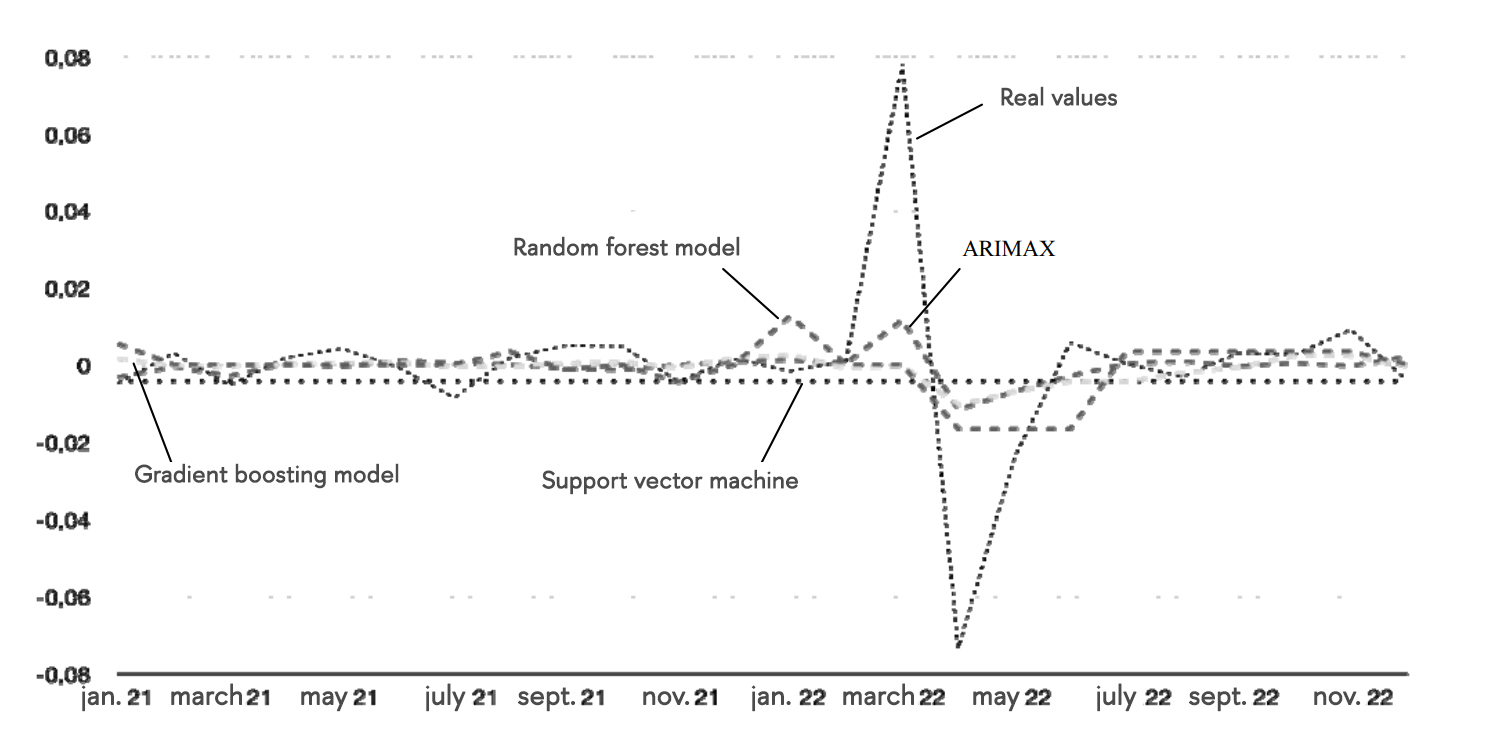HSE Researchers Demonstrate Effectiveness of Machine Learning in Forecasting Inflation

Inflation is a key indicator of economic stability, and being able to accurately forecast its levels across regions is crucial for governments, businesses, and households. Tatiana Bukina and Dmitry Kashin at HSE Campus in Perm have found that machine learning techniques outperform traditional econometric models in long-term inflation forecasting. The results of the study focused on several regions in the Privolzhskiy Federal District have been published in HSE Economic Journal.
Inflation forecasting is crucial for the economy, particularly since Russia's transition to an inflation targeting regime in 2014. This means that the Bank of Russia sets specific inflation targets and employs a range of tools to meet them.
Various data is used to predict inflation, including the consumer price index, the unemployment rate, exchange rates, and the Central Bank rate. To systematise this information for forecasting, economists at the HSE Campus in Perm used data from the Unified Interdepartmental Statistical Information System.
The researchers' main objective was to determine which model predicts regional inflation more accurately: traditional econometric time series models or more recent machine learning methods. The study analysed data from 14 regions in the Privolzhskiy Federal District from January 2010 to December 2022. R Studio and Python were used for the analysis: time series forecasting was performed in R Studio, while machine learning models, including support vector machines, gradient boosting, and random forests, were implemented in Python. The forecasts were conducted on test samples, which helped prevent model overfitting and provided more accurate estimates.
The authors employed a cross-validation method using test samples of equal size. This approach allows models to be trained on data from one period and tested on data from another, ensuring stability and accuracy of the forecasts.
'To ensure accurate performance of machine learning methods, it is essential to select the optimal hyperparameters for the models. Hyperparameters differ from other model parameters in that they are set before training begins and define the model's specifications. Cross-validation is employed to select the optimal hyperparameters. When cross-validating time series, the training data precedes the test data without overlap, unlike in standard data validation,' according to Tatiana Bukina, Associate Professor, Faculty of Computer Science, Economics, and Social Sciences, HSE Campus in Perm.
The study found the gradient boosting model to be the most accurate of all machine learning models considered for predicting regional inflation. It delivers more accurate forecasts than autoregressive models over more time horizons. Thus, at forecasting horizons of 3, 6, 21, and 24 months, the gradient boosting model outperforms the basic AR(1) model by 20.3%, 16.2%, 72.5%, and 77.7%, respectively. The AR(1) model, a statistical tool for analysing and predicting time series, assumes that the current value of a series depends on its previous value plus a random error.
The random forest model and the support vector machine also demonstrated accurate forecasts over the long horizons of 21 and 24 months, outperforming the AR(1) model by 72.5% and 77.7%, respectively. A random forest combines multiple decision trees to enhance the accuracy and stability of forecasts, and then uses regression to average the predictions or select the most frequent value. The support vector machine identifies the optimal line that separates the data while minimising classification errors.

According to the authors, their results confirm that machine learning methods can be effective for forecasting inflation across various time horizons.
Tatiana Bukina notes, 'Our research has demonstrated that machine learning provides more reliable tools for long-term forecasts. However, traditional econometric models continue to play a crucial role in short-term forecasts and should not be entirely excluded from analysts' toolkits. Combining econometric modelling with machine learning methods can significantly improve the accuracy of regional inflation forecasts. This is particularly important in an environment characterised by high uncertainty and rapid changes in economic conditions.'
The study also highlighted the specific characteristics of inflation forecasting for different regions. For example, in machine learning models, inflation seasonality was observed only in the Perm, Nizhny Novgorod, Penza, and Saratov regions. In the Republic of Tatarstan, the specific month for which the forecast was calculated proved to be a significant factor.
In the random forest model, the average inflation value for the previous three months emerged as a significant factor for the Republic of Mordovia, Nizhny Novgorod and Ulyanovsk regions, and the Chuvash Republic.
Each region has unique characteristics related to its economic structure, natural resources, and geographical location. These factors account for the variations in inflation dynamics and key macroeconomic indicators.
See also:
See, Feel, and Understand: HSE Researchers to Explore Mechanisms of Movement Perception in Autism
Scientists at the HSE Cognitive Health and Intelligence Centre have won a grant from the Russian Science Foundation (RSF) to investigate the mechanisms of visual motion perception in autism. The researchers will design an experimental paradigm to explore the relationship between visual attention and motor skills in individuals with autism spectrum disorders. This will provide insight into the neurocognitive mechanisms underlying social interaction difficulties in autism and help identify strategies for compensating for them.
Scholars Disprove Existence of ‘Crisis of Trust’ in Science
An international team of researchers, including specialists from HSE University, has conducted a large-scale survey in 68 countries on the subject of trust in science. In most countries, people continue to highly value the work of scientists and want to see them take a more active role in public life. The results have been published in Nature Human Behaviour.
Education System Reforms Led to Better University Performance, HSE Researchers Find
A study by researchers at the HSE Faculty of Economic Sciences and the Institute of Education have found that the number of academic papers published by research universities in international journals has tripled in the past eight years. Additionally, universities have developed more distinct specialisations. Thus, sectoral universities specialising in medical, pedagogical, technical, and other fields are twice as likely to admit students to target places. The study has been published in Vocation, Technology & Education.
Scientists Record GRB 221009A, the Brightest Gamma-Ray Burst in Cosmic History
A team of scientists from 17 countries, including physicists from HSE University, analysed early photometric and spectroscopic data of GRB 221009A, the brightest gamma-ray burst ever recorded. The data was obtained at the Sayan Observatory one hour and 15 minutes after the emission was registered. The researchers detected photons with an energy of 18 teraelectronvolts (TeV). Theoretically, such high-energy particles should not reach Earth, but data analysis has confirmed that they can. The results challenge the theory of gamma radiation absorption and may point to unknown physical processes. The study has been published in Astronomy & Astrophysics.
Chemists Simplify Synthesis of Drugs Involving Amide Groups
Chemists from HSE University and the Nesmeyanov Institute of Organoelement Compounds of the Russian Academy of Sciences (INEOS RAS) have developed a new method for synthesising amides, essential compounds in drug production. Using a ruthenium catalyst and carbon monoxide under precisely controlled reaction conditions, they successfully obtained the target product without by-products or complex purification steps. The method has already been tested for synthesising a key component of Vorinostat, a drug used to treat T-cell lymphoma. This approach could lower the cost of the drug by orders of magnitude. The paper has been published in the Journal of Catalysis. The study was supported by the Russian Science Foundation.
Scientists Examine Neurobiology of Pragmatic Reasoning
An international team including scientists from HSE University has investigated the brain's ability to comprehend hidden meanings in spoken messages. Using fMRI, the researchers found that unambiguous meanings activate brain regions involved in decision-making, whereas processing complex and ambiguous utterances engages regions responsible for analysing context and the speaker's intentions. The more complex the task, the greater the interaction between these regions, enabling the brain to decipher the meaning. The study has been published in NeuroImage.
Scientists Present New Solution to Imbalanced Learning Problem
Specialists at the HSE Faculty of Computer Science and Sber AI Lab have developed a geometric oversampling technique known as Simplicial SMOTE. Tests on various datasets have shown that it significantly improves classification performance. This technique is particularly valuable in scenarios where rare cases are crucial, such as fraud detection or the diagnosis of rare diseases. The study's results are available on ArXiv.org, an open-access archive, and will be presented at the International Conference on Knowledge Discovery and Data Mining (KDD) in summer 2025 in Toronto, Canada.
Hi-Tech Grief: HSE Researchers Explore the Pros and Cons of Digital Commemoration
Researchers at HSE University in Nizhny Novgorod have explored how technological advancements are transforming the ways in which people preserve the memory of the deceased and significant events. Digital technologies enable the creation of virtual memorials, the preservation of personal stories and belongings of the deceased, interaction with their digital footprint, and even the development of interactive avatars based on their online activity. However, these technologies not only evoke nostalgia and provide a sense of relief but can also heighten anxiety and fear, and delay the process of accepting loss. The study has been published in Chelovek (The Human Being).
Scientists Find Out Why Aphasia Patients Lose the Ability to Talk about the Past and Future
An international team of researchers, including scientists from the HSE Centre for Language and Brain, has identified the causes of impairments in expressing grammatical tense in people with aphasia. They discovered that individuals with speech disorders struggle with both forming the concept of time and selecting the correct verb tense. However, which of these processes proves more challenging depends on the speaker's language. The findings have been published in the journal Aphasiology.
Implementation of Principles of Sustainable Development Attracts More Investments
Economists from HSE and RUDN University have analysed issues related to corporate digital transformation processes. The introduction of digital solutions into corporate operations reduces the number of patents in the field of green technologies by 4% and creates additional financial difficulties. However, if a company focuses on sustainable development and increases its rating in environmental, social, and governance performance (ESG), the negative effects decrease. Moreover, when the ESG rating is high, digitalisation can even increase the number of patents by 2%. The article was published in Sustainability.



